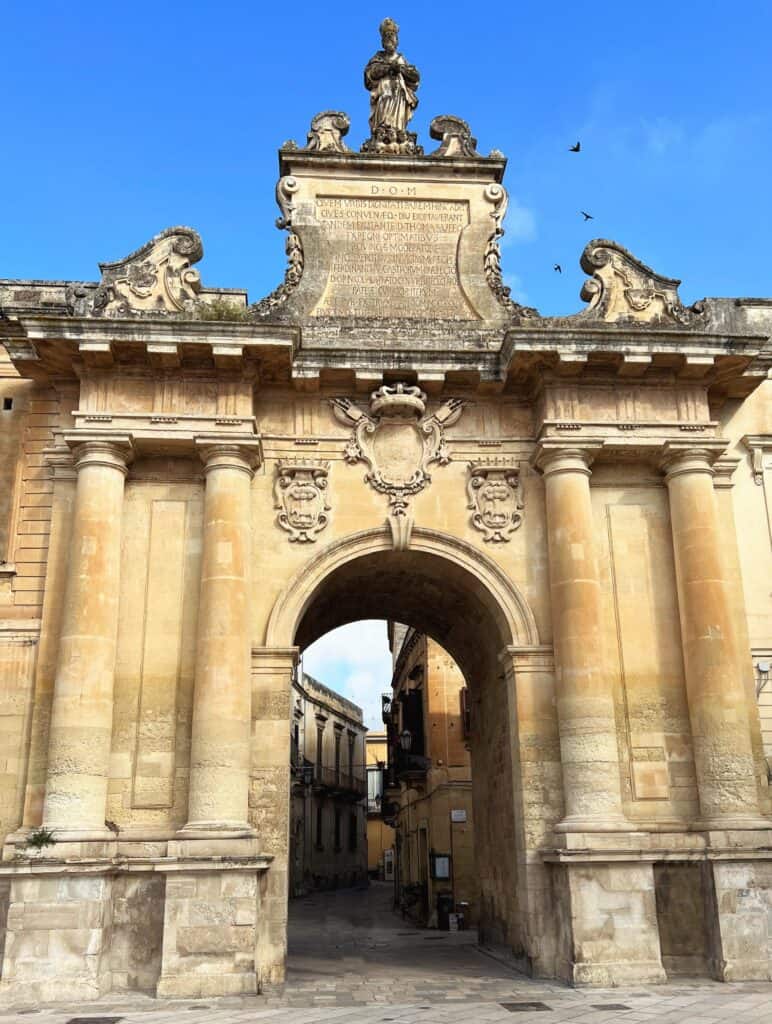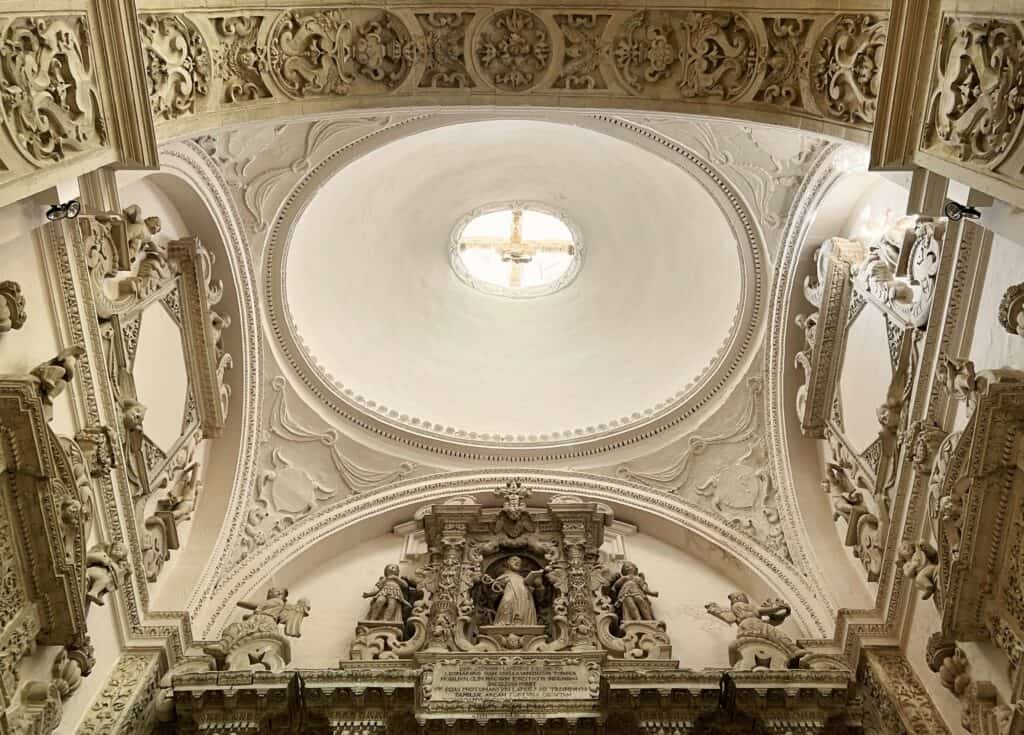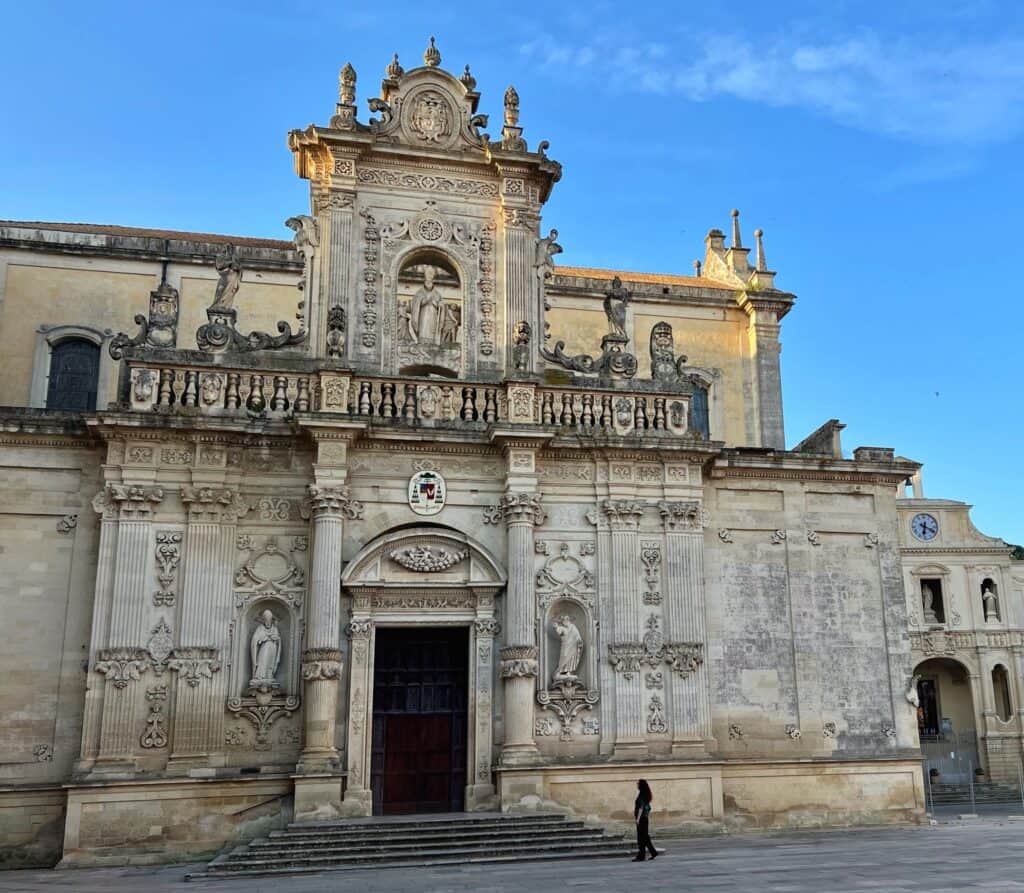A Guide to Lecce’s Exuberant Baroque Architecture
Lecce’s buildings teem with life. Besides Catholic saints and legends, this fanciful world includes medieval fables and pagan mythology mixed with everyday scenes. Legions of babies spiral up columns, cavort en masse across façades and swarm over altarpieces. The masses of fruit defy human comprehension. Even Sicily’s wilder Baroque churches can’t match the density and ebullience of Barocco Leccese carvings.
Overwhelming displays fusing art and architecture are a hallmark of the Baroque style, which developed during the Catholic church’s Counter-Reformation building spree. Yet many historians don’t consider Lecce’s architecture to be truly Baroque. They find the structures’ underlying forms too stolid and medieval, without the swooping curves used by architects like Francesco Borromini to create a sense of movement. In other words, Lecce’s version of Baroque added spectacular new icing to the same square cake.

With the cornucopia of forms on show, it’s hard to imagine how anyone visiting Lecce could focus on what it lacks. Artisans specializing in paper-mâchè and working with the ultra-soft local stone created a new level of intricacy. Buildings and streets reveal different details with multiple viewings; ideally one can take the city in over the course of at least a few days. We’ve put together a guide to Lecce’s Baroque architecture, with highlights marked on our Google map.
Orientation
While most of Lecce’s buildings date from the Baroque era, they inhabit a decidedly medieval layout. The pedestrian centro historico doesn’t have a single boulevard, much less a street grid. And the organic layout means that even major landmarks appear and disappear from view quickly.

Two very different squares anchor the city center. The Piazza Sant’Oronzo’s open oval contains a variety of structures from different eras, while the closed square of the Piazza Duomo is ecclesiastical and entirely Baroque. Via Vittorio Emanuele II runs between the piazzas, turning into Via Libertini at the Duomo. Via Libertini runs out to the Porta Rudiae, one of the monumental gates left over from the former city walls. Another historic gate, the Porta Napoli, links diagonally to the Duomo along the Via Palmieri.
A Brief History of Lecce
Located in the southeastern heel of Italy’s boot, Lecce grew into a prosperous farming settlement under the ancient Romans.

The Roman Empire’s collapse left the region around Lecce vulnerable to invasions and raids from the sea. Most inhabitants moved inland, and the predominantly agrarian area remained isolated for the next thousand years. Byzantines, Normans, and various European overlords came and went over the centuries, with the Spanish finally wrangling control around the 15th century. A brief visit from Emperor Charles V resulted in massive city walls, a castle, and official recognition of Lecce as Puglia’s capital.


Teatro Romano and Santa Chiara
The second half of the 16th century through the end of the 17th saw an uptick in Lecce’s fortunes, providing the funding for the Baroque building boom. Well-to-do residents kept up with trends outside Puglia, albeit second-hand and generally at some delay. Most architects in Lecce probably encountered Baroque developments through two-dimensional drawings rather than in person, resulting in the city’s highly idiosyncratic take on the style.
Lecce’s Baroque Churches

The Counter-Reformation brought a fresh set of Catholic orders to Lecce, who promptly began competing with one another via church commissions, inaugurating the Barocco Leccese. Major structures tend to feature work by the same handful of artists, who often contributed to one another’s designs with altars, portals, and other small elements. Of these, the most famous is Giuseppe Zimbalo, nicknamed Lo Zingarello (“The Little Gypsy”), who designed the Duomo and its bell tower.

Of around a dozen large churches exemplifying Lecce’s version of the Baroque style, we’ve included the most significant plus a few others we particularly admired. We recommend purchasing the €11 LeccEcclesiae pass which covers entrance to the Duomo, Santa Croce, San Matteo, and Santa Chiara churches, as well the Antico Seminario and Museo di Arte Sacra (Diocesian Museum.) Purchase tickets online, in the main office (Piazza del Duomo 5), or at the Santa Croce ticket office. LeccEcclesiae sites are open from 9-9 April-September, and 9-6 October-March.
The other churches are free to visit, although hours can vary.
Piazza Duomo and Cathedral
Normans began Lecce’s first Duomo in 1114, but the medieval bell tower’s collapse in the early 17th century precipitated Zimbalo’s commission to redesign both structures. The Baroque cathedral was constructed between 1659 and 1670, and the bell tower from 1661 to 1682. Development of the piazza, including the Seminary and Bishop’s Palace, continued for another century.

At first glance, Lecce’s Piazza Duomo might not appear to have much in common with famous Baroque spaces. It doesn’t have welcoming curves like the colonnade in front of St. Peter’s or the sweeping elegance of Syracuse’s main piazza. But Lecce’s cathedral and its surrounding buildings make a dramatic impression, showcasing the city’s Baroque innovations on its own terms.

The first thing visitors see when entering the piazza is a spectacular entrance on the cathedral’s side. Normally a church’s grandest portals go on the front façade, but Zimbalo’s unconventional design embraces the Baroque idea of framing views to orchestrate awe. Successive renovations to the piazza strengthened the harmony between the buildings, an effect rarely seen before the Baroque period.


Bernini’s Baldacchino in St. Peter’s helped popularize tortili (twisted) columns, which appealed to Baroque architects for several reasons. The dynamic spiral form creates a sense of movement, and also blurs the line between structure and ornament. On a symbolic level, the shape references a legendary set of columns brought to Rome by Constantine, supposedly from Jerusalem’s Temple of Solomon.
Tickets to the cathedral bell tower via lift cost €12 for a 20-minute visit. Reserve time slots online or at the ticket office. The tower was under renovation when we visited but reportedly provides views of the Adriatic Sea, occasionally all the way to Albania.
Basilica di Santa Croce


Thanks to its incredible façade – which probably has more carvings than all the churches of Florence put together – Santa Croce is generally considered the pinnacle of the Barocco Leccese. Taken as a whole, the church shows an extraordinary fusion of medieval architecture with Baroque forms – such as the rose window paired with a split curved pediment on top. Changing tastes may account for the lack of uniformity, as construction spanned nearly a century (1549-1646) under several different designers.



Gabriele Riccardi contributed the lower façade and adjacent monastery (the Palazzo dei Celestini), while Cesare Penna completed the top portion, and Francesco Antonio Zimbalo provided portals and an altar.
Chiesa di San Matteo


Squeezed into a compact corner plot, the city’s sole “true” Baroque building stands out for its curving façade. While other structures rely on ornamentation to enliven their flat fronts, the San Matteo adopts the innovations of Francesco Borromini in Rome. It pulses out on the lower level, and curves inward on top, drawing passerbys in. Constructed from 1667 to 1700, the church features a slightly elliptical floor plan and a star vault in the apse. Sources are divided on whether the architect was Achille Larducci or his son Giovanni Andrea.
Chiesa di Santa Teresa and Basilica del Rosario e di San Giovanni Battista
The order of Carmelites, engaged in a fierce rivalry with the Dominicans down the street, commissioned a young Zimbalo to design a grand new church in 1620. Construction stopped after 10 years, leaving the façade unfinished.


The unfinished facade of Santa Teresa and the ceiling over the crossing in San Giovanni Battista
Down the street from the Santa Teresa, Zimbalo began another major church in 1691, at age 70. He also helped the Dominicans to finance the ambitious project, which originally included a large dome. After his death in 1710, Cesare Penna took over until the church’s completion in 1728. The somewhat unusual floor plan fuses a Greek cross with an octagon.
Chiesa di Sant’Irene dei Teatini

Miserable conditions around the Jewish Quarter inspired the Theatine order to commission the Sant’Irene shortly after arriving in Lecce. Architect Francesco Grimaldi drew upon the design of Rome’s Sant’Andrea delle Valle, which he had helped to build. After nearly 50 years of construction, the building was finished in 1639. Just 17 years later Lecce changed its patron saint from Irene to Orozco, who allegedly saved the region from a dreadful plague in 1656.
Palazzos and Other Baroque Buildings

Eventually the Baroque style spread beyond Lecce’s churches. Local nobility incorporated elaborate carvings and dynamic shapes into their palazzos, along with typical Spanish elements like wrought iron balconies. Nearly all of these grand homes remain privately-owned but their lively façades embellish the city’s streets.


Pietra leccese (‘Lecce stone’) is famous for its softness. After carving it, masons soaked the limestone in a mixture containing whole milk to harden it and decrease its porosity. Nonetheless, most buildings in Lecce – like the Palazzo Marrese above – show some level of decay.
Chiesa dei Santi Niccolò e Cataldo and the Cimitero di Lecce

Other than the Roman relics and a few modern buildings, not much remains in the centro historico to connect Lecce’s Baroque to the centuries preceding and following it. But the craftmanship and creative exuberance associated with the Barocco Leccese can also be discerned in an older church and newer cemetery just beyond the city center.

The Chiesa dei Niccolò e Cataldo was constructed in 1180 by Count Tancred, not long before his brief reign as King of Sicily. Norman architecture’s strong Islamic influence shows in the intricate carvings of the entrance, which were preserved during Baroque renovations. Gabriele Riccardi’s contributions to the latter include a statue of San Nicola and one of the cloisters.
Next to the church, Lecce’s cemetery continues the city’s tradition of fantastical stonework. It’s a world unto itself, mixing simple slabs with elaborate funerary monuments. Not all the tombs date to the Baroque period, but they all seem to share the same reverence.

The Cimitero di Lecce lies about 10 minutes’ walk from the Porta Napoli, most of it down a cypress-lined pathway. SS Niccolò e Cataldo is open 9:30-12:30 on Monday, Thursday, and Saturday only.
Resources


Lecce’s official tourist office is in the Palazzo del Seggio (a.k.a Il Sedile), in the Piazza Sant’Oronzo. The online tourism portal is at visitlecce.eu.
For information on getting in and out of Lecce, see our post on traveling Puglia without a car. We also have posts on Old Bari, day trips from Bari, and the rock-cut architecture of Matera.
For more on Baroque architecture, see our posts on Borromini and Ragusa, Sicily.

